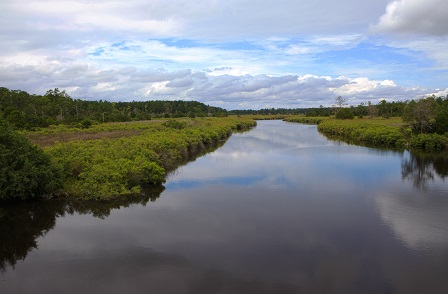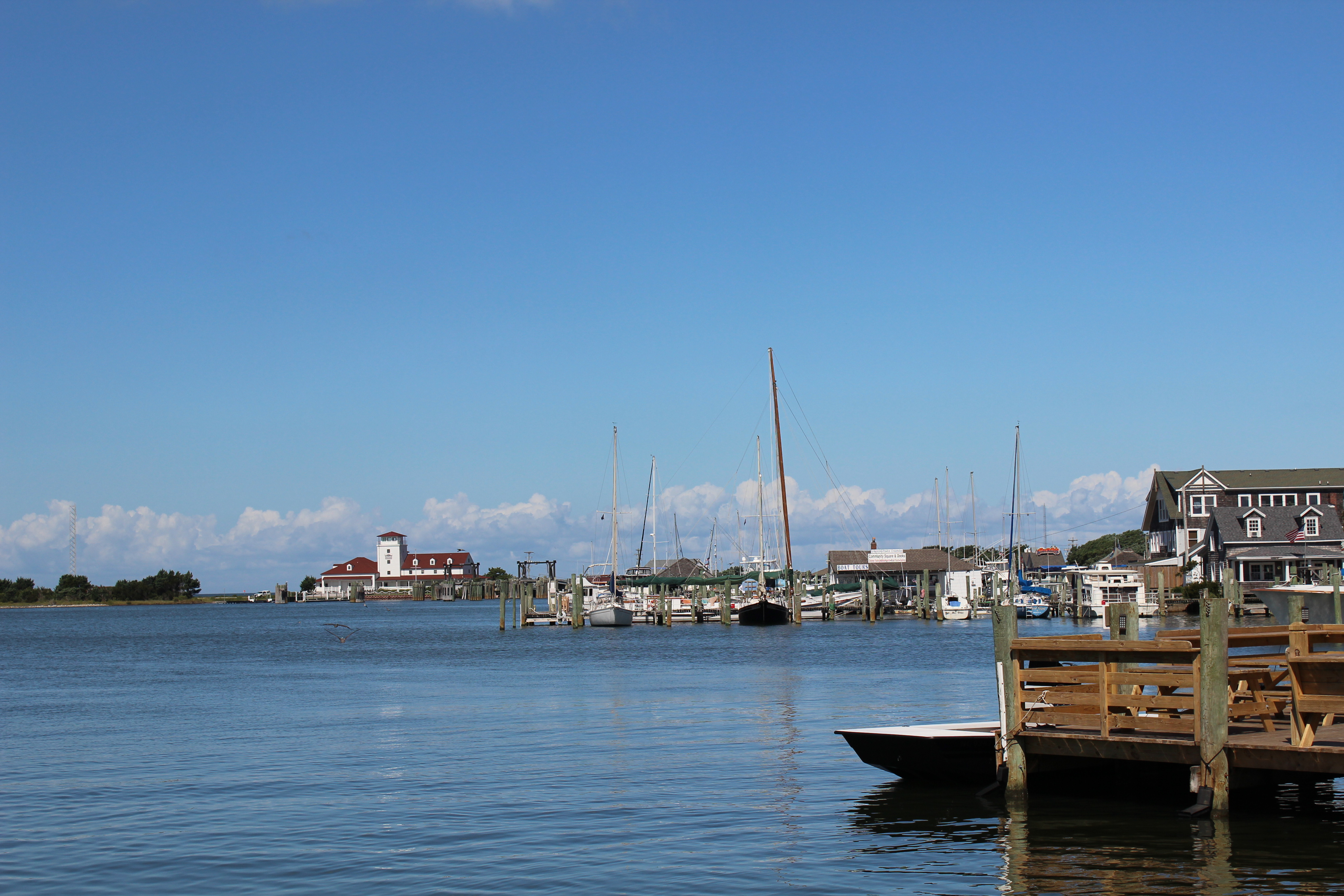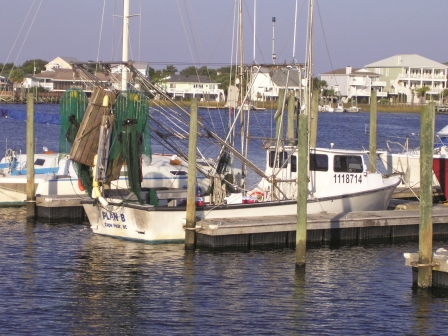At War in the Wetlands

There’s a war being waged in wetlands.
The enemy — Phragmites australis — appears innocuous enough at first glance: With blue-green leaves and cane-like stems topped with purplish plumes, the tall marsh plants curtsy and dance in the breeze.
But the aesthetic deception ends at their “feet.” These moisture-loving rhizomes and fibrous roots not only anchor the plant in place, but also branch out to reproduce exponentially. Even the smallest rhizome fragment can float away to regenerate itself in a new locale.
In just one growing season, dense growths can crowd out native vegetation and wildlife habitat — threatening entire aquatic ecosystems. Phragmites australis is particularly aggressive in low-salinity marshes and in wetland areas where salinity levels are lowered by human-induced changes.
It’s little wonder that fast-growing coastal North Carolina is a primary battlefront — and that state resource managers are raising a battle cry to halt the invasion.
Michele Droszcz, of the N.C. Coastal Reserve, says that combatting Phragnites australis requires a variety of strategies:
- recognizing the enemy;
- understanding its potential environmental impact;
- developing methods to eradicate or control its colonization in the coastal region; and
- finding resources to win the war.
Droszcz is site manager at Kitty Hawk Woods and Currituck Banks reserves in the northernmost reach of the coast. She is leading a research and outreach effort to deliver valuable information about Phragmites australis to the public, developers, resource managers and government agencies.
With the help of a grant from the Albemarle-Pamlico National Estuary Program (APNEP), Droszcz is partnering on a variety of fronts with staff from APNEP, the Rachel Carson Estuarine Research Reserve and N.C. Cooperative Extension.
A 2004 summer workshop drew participation from public and private sectors to learn the latest scientific data on Phragmites australis, to share experiences from the field, and to create an information-sharing network. A forthcoming brochure will target coastal landowners with identification and management tips.
The APNEP grant also is underwriting research at Kitty Hawk Woods to determine which weapons and strategies are most effective against the growing menace.
Knowing the Enemy
Technically, Phragmites australis is not a new arrival to the plant realm in North Carolina, nor in North America for that matter.
“Phragmites australis likely was a minor component In North American wetlands for thousands of years,” according to Alexander Krings, curator of the North Carolina State University Herbarium. “We know this from the accounts in floras from the 1800s and 1900s.”
Floras are treatises on plants of a particular area or period. Such literature describes Phragmites australis, as “occasional,” “not common,” and “rare to occasional” in ponds and marshes from Canada to New jersey.
Yet, by the 1960s, it had been recorded in nearly all U.S. states — and widespread enough in New England to be considered a “nuisance” in coastal and inland areas.
“Early speculations for the change included environmental and genetic causes, and raised questions as to whether habitat changes mights be responsible,” Krings says.
Certainly, he notes, the expansion of Phragmites australis parallels the loss of wetlands in this country. Between the 1780s and the 1980s, 53 percent of all tidal and nontidal wetlands in the United States were altered, filled or destroyed, according to scientific literature.
Still, scientists were stymied by the shift from peaceful coexistence of Phragmites australis to its “take-no-prisoners” dominance in wetlands.
Genetic studies would reveal some answers. Yale researcher Kristen Salstonstall collected leaf samples from 1997 to 2001 throughout the plant’s North American and European range.
For genetic comparisons, she extracted DNA from fresh samples as well as historic herbarium specimens. When possible, fresh samples were collected from the same localities as herbarium specimens.
Her study shows that a non-native strain of Phragmites australis is responsible for the spread of the nuisance aquatic plant since the 1960s.
In a paper published by the National Academy of Science in 2002, “Cryptic Invasion by a Non-native Genotype of the Common Reed, Phragmites australis, into North America,” Salstonstall writes:
Results indicate that an introduction has occurred, and the introduced type has displaced native types as well as expanded to regions previously not known to have Phragmites australis.
In fact, she concludes, native types of Phragmites australis have disappeared from New England — and may be threatened in other parts of North America.
Finding Solutions
The “cryptic invasion” discovery provides a scientific explanation of the aggressive characteristics of Phragmites australis in recent decades. But, resource managers are left with the daunting challenge to find effective and efficient counter attack methods.
The Kitty Hawk Woods research is a beginning volley.
“Some resource managers dealing with hundreds of acres of Phragmites australis have great resources to map and combat its spread,” Droszcz explains.
For example, many National Wildlife Refuges employ aerial spraying with a glysphosate herbicide late In the growing season, followed by prescribed burning or removal of dead stalks.
However, wide-scale spraying is not an option at reserves such as Kitty Hawk Woods because of the possible negative effects on environmentally important nontarget plants.
Instead, the APNEP-funded study is taking a smaller-scale approach, Droszcz explains. As a first step, Elizabeth Noble, director of the Remote Sensing Lab at Elizabeth City State University, helped map patches of Phragmites australis in Kitty Hawk Woods using Global Information System (CIS) technology.
As high-tech as it sounds, someone still must physically walk the marshes to locate the patches and send the positioning signals to the satellite using a hand-held device, Noble explains. Subsequently, the data is downloaded to a computer to overlay on available topographic maps with the same coordinates.
“It was no walk in the park for the student intern,” asserts Kyle Hall, the Elizabeth City State CIS technician working with Droszcz on the project.
Hall searched the scientific literature to learn about the various control methods being used in both large- and small-scale situations.
“There never has been a side-by-side comparison study done before as far as we can tell,” he notes.
For the study, he constructed a total of six 30′ x 30′ sections in dense patches of Phragmites australis to test six different control approaches:
- cut and bum;
- cut once at the beginning of the growing season;
- cut monthly to knee-height;
- mash down and cut below water level to “drown” canes;
- cut to the ground and cover with plastic to cut off sunlight needed for photosynthesis; and,
- cut and spray with aquatic herbicide.
“Some of the literature mention chopping the rhizomes, but we did not use this method because of the danger that pieces could float away and colonize in other areas,” Hall says.
So far, the monthly, multiple-cut approach is looking good, and the drowning is promising, he reports. Though the grant support has ended, Droszcz and Hall will continue the study through another growing season.
Preserving Diversity
Nearby at The Nature Conservancy’s Nags Head Woods, Aaron McCall also is combating Phragmites in patch-by-patch skirmishes. The machete had been his weapon of choice until recently when he switched to a gas-powered hedge trimmer.
For now, he is concentrating efforts in freshwater ponds filled with diverse aquatic species — including a rare water violet.
‘You have to choose your battles,” says McCall, who has tried varied control methods from the cut-spray-remove thatch approach to the cut-and-drown approach.
“I haven’t attacked a patch of Phragmites at the edge of the marsh (on the sound side), where it is acting as a buffer from wind and wave erosion. Removing it may cause more harm than good,” he explains.
Patches of the invasive aquatic plant were first detected in the pristine maritime forest about seven years ago. McCall has been on the front lines there for more than five years.
The Kitty Hawk Woods’ staff has been waging the battle for about that long. “All control methods are labor intense and require diligent monitoring,” says Hall.
But with biodiversity of coastal wetlands, shallow sounds and productive estuaries from Corolla to Calabash at stake, finding a way to win the battle is an imperative.
This article was published in the Holiday 2004 issue of Coastwatch.
For contact information and reprint requests, visit ncseagrant.ncsu.edu/coastwatch/contact/.
- Categories:


